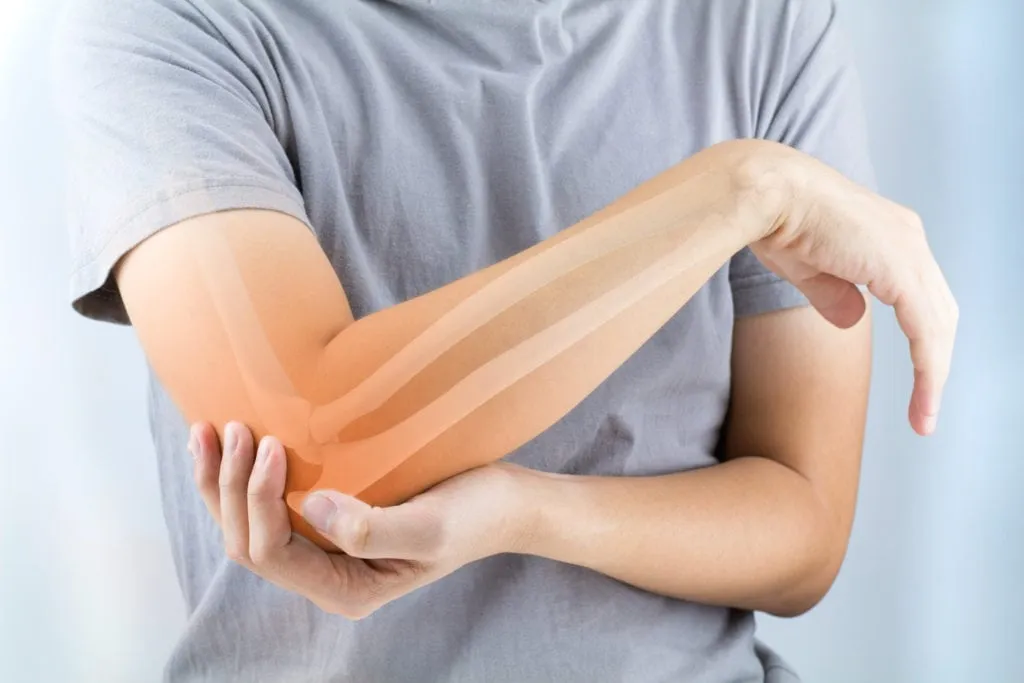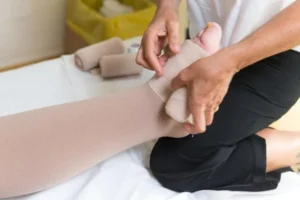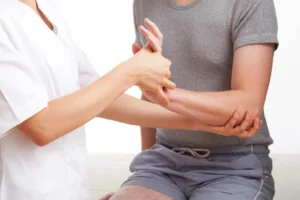Tendonitis, is the inflammation or irritation of a tendon the thick, fibrous cord that connects muscle to bone. When tendons are healthy, they glide smoothly, allowing your muscles to pull on your bones and create movement. But when a tendon becomes inflamed, every motion feels like a painful tug-of-war. The result? Pain, tenderness, and difficulty moving the affected joint.
While it may sound like a minor issue, tendonitis can have a big impact on daily life. Imagine a tennis player with elbow tendonitis trying to serve, or an office worker with wrist tendonitis struggling to type. Even simple actions like climbing stairs or lifting groceries can feel overwhelming when tendonitis sets in.
The condition can affect almost any tendon in the body, but it’s most common in the shoulders, elbows, wrists, knees, and heels. You may have heard of it by specific names: “tennis elbow,” “golfer’s elbow,” “jumper’s knee,” or “Achilles tendonitis.” Each refers to the same underlying issue—inflamed tendons caused by overuse, injury, or strain.
Tendonitis is often temporary if treated early, but if ignored, it can become chronic and lead to more serious tendon damage. That’s why understanding what it is, how it develops, and how to manage it is essential for long-term joint and muscle health.
Why Tendonitis is More Common Than You Think
You might think tendonitis only happens to athletes, but that’s far from true. In fact, anyone can develop tendonitis, regardless of age or fitness level. It’s one of the most common musculoskeletal problems today, and modern lifestyles have made it even more widespread.
Think about how many repetitive tasks you do daily. Typing, texting, gardening, lifting, cleaning, even playing musical instruments ، all involve repetitive motions that can strain your tendons over time. Add poor posture, lack of stretching, and sudden bursts of activity (like weekend sports), and you’ve got the perfect setup for tendonitis.
Age is another factor. As we get older, our tendons naturally lose flexibility and strength. They’re more prone to micro-tears and inflammation, which explains why tendonitis is more common in middle-aged and older adults. But with technology driving younger generations to spend hours on keyboards and smartphones, even teens and young adults are reporting cases of tendonitis.
The truth is, tendonitis doesn’t discriminate. Whether you’re an athlete, a construction worker, a student, or a retiree, if your tendons are overworked, under-prepared, or injured, tendonitis can develop. The good news? With the right treatment and preventive measures, most cases can be managed effectively before they become chronic.
Common Areas Affected by Tendonitis
While tendonitis can occur anywhere a tendon connects muscle to bone, some areas are more commonly affected because they bear more stress or are prone to repetitive use.
- Shoulder (Rotator Cuff Tendonitis): Common in athletes, swimmers, and people with overhead jobs. Pain is often felt when lifting the arm.
- Elbow (Tennis Elbow & Golfer’s Elbow): Caused by repetitive gripping or wrist motion. Pain radiates along the forearm.
- Wrist (Wrist Tendonitis): Frequent in office workers, typists, and gamers. Causes pain when bending or twisting the wrist.
- Knee (Patellar Tendonitis / Jumper’s Knee): Seen in athletes who jump or run often. Pain occurs just below the kneecap.
- Heel (Achilles Tendonitis): Affects runners and people who walk long distances. Pain is felt in the back of the heel, especially in the morning.
Each of these areas is subjected to frequent stress, which makes them more vulnerable. For example, the rotator cuff tendons are constantly in motion when you reach overhead, while the Achilles tendon absorbs the impact of every step you take.
By recognizing the most common sites of tendonitis, you can better identify early warning signs and take steps to reduce strain before the condition worsens.
How Tendons Become Inflamed
Tendons become inflamed when they’re subjected to more stress than they can handle. This usually happens in one of two ways: through sudden injury or chronic overuse.
With sudden injury, the tendon is forced to stretch or bear a load it isn’t prepared for—like landing awkwardly after a jump or lifting something too heavy. This can cause small tears in the tendon fibers, leading to swelling, pain, and inflammation.
Chronic overuse is even more common. Repeating the same motion day after day causes tiny micro-tears that don’t have time to heal. Over time, this leads to irritation and inflammation. Imagine bending a paperclip back and forth repeatedly—it doesn’t break right away, but eventually, the stress weakens it until it snaps. Tendons react the same way under repeated strain.
Inflammation is the body’s natural defense mechanism, sending blood and healing cells to the injured area. But because tendons don’t have great blood supply, healing is slow, and inflammation can become prolonged. That’s when tendonitis turns into a persistent, painful condition.
Understanding how tendons become inflamed underscores the importance of rest, recovery, and balanced movement. Without these, even the strongest tendons can become vulnerable to injury.
Causes of Tendonitis
Repetitive Motion and Overuse
Repetitive motion is the number one cause of tendonitis. When you perform the same movement over and over, the tendons experience constant friction and stress. Over time, this leads to microscopic tears in the tendon fibers, which trigger inflammation.
Take typing, for instance. Hours spent at a keyboard without breaks puts stress on the wrist tendons. Similarly, athletes who run, swing a racket, or throw a ball repeatedly are at higher risk. Even hobbies like knitting, painting, or playing an instrument can cause tendonitis if done excessively without proper rest.
The problem is that tendons don’t always give immediate feedback. You might not feel pain during the activity itself. Instead, discomfort shows up later—when inflammation builds up. By then, the tendon has already been stressed beyond its limit.
The good news is that this type of tendonitis is highly preventable. Taking regular breaks, practicing proper technique, and including stretching and strengthening in your routine can significantly reduce the risk. Think of your tendons like car tires—if you keep driving without rest or rotation, they wear down faster. Give them breaks, and they’ll last longer.
Injuries and Strain
In addition to overuse, sudden injuries can cause tendonitis. A fall, awkward movement, or lifting something too heavy can overstretch or tear a tendon, sparking inflammation. Unlike chronic overuse tendonitis, injury-related cases usually have a clear starting point—you remember the exact moment when pain began.
For example, a person might strain their Achilles tendon during a sudden sprint, or a construction worker might injure their shoulder tendon while lifting an awkward load. These strains damage the tendon fibers, and the body responds with swelling and pain as it tries to heal.
One challenge with tendon injuries is that people often ignore them, thinking the pain will “just go away.” But if the tendon doesn’t get adequate rest, the damage worsens, leading to chronic tendonitis. That’s why addressing even minor tendon injuries right away is crucial.
Protecting your tendons from injury is about preparation and awareness. Warming up before physical activity, using proper form, and knowing your limits are key to keeping tendons healthy and preventing inflammation from setting in.
Age and Degenerative Changes
As we age, our tendons naturally change. They lose flexibility, become less elastic, and weaken due to years of use. This degeneration makes them more prone to micro-tears and inflammation, even during normal activities that wouldn’t have caused problems in youth.
For many people over 40, tendonitis becomes a recurring issue. The rotator cuff in the shoulder, Achilles tendon, and patellar tendon in the knee are particularly vulnerable. Everyday movements like reaching overhead, climbing stairs, or going for a brisk walk can suddenly trigger pain.
Part of the reason is reduced blood flow. Tendons already have limited circulation, and with age, this supply becomes even less efficient. That means healing takes longer, and inflammation lingers. It’s one reason older athletes need longer recovery times compared to younger ones.
Age-related tendonitis doesn’t mean you should stop being active—it just means you need to be smarter about it. Incorporating flexibility training, low-impact exercises, and proper recovery time can help older adults maintain tendon health and avoid painful flare-ups.
Underlying Health Conditions
Certain health conditions make people more prone to tendonitis. For example:
Diabetes: High blood sugar can weaken tendons and make them more susceptible to injury.
Rheumatoid arthritis and gout: Both conditions cause inflammation, which can spread to tendons.
Thyroid disorders: Hormonal imbalances may affect tendon strength and elasticity.
Infections (rare cases): Sometimes, bacteria can infect a tendon sheath, causing inflammation.
Obesity is another factor, as excess weight places extra stress on tendons, especially in the knees, ankles, and feet. People taking certain antibiotics (like fluoroquinolones) or corticosteroids also face a higher risk, since these medications can weaken tendons and increase the likelihood of rupture or inflammation.
Early Signs and Symptoms
Pain and Tenderness Near a Joint
The hallmark symptom of tendonitis is pain near a joint. This pain often starts as a dull ache during movement but can progress to sharp, stabbing pain if ignored. It typically worsens when you use the affected tendon and eases with rest.
For example, in tennis elbow, pain appears on the outside of the elbow and may radiate down the forearm. In Achilles tendonitis, pain is felt at the back of the heel, especially when pushing off the foot while walking or running. In patellar tendonitis, the discomfort is just below the kneecap.
The area is usually tender to the touch. Pressing on the tendon often reproduces the pain, making it easy to pinpoint the source. This localized tenderness is one of the key differences between tendonitis and other joint conditions like arthritis, where pain is more diffuse.
Ignoring this early warning sign is risky. Pain is your body’s way of saying the tendon is under too much stress. If you keep pushing through it, small micro-tears can become bigger injuries, leading to chronic tendonitis or even rupture.
Swelling and Warmth
Another common sign of tendonitis is swelling around the affected tendon. This swelling may be subtle at first, but in more severe cases, it can be visible and accompanied by redness. The area might also feel warm to the touch, which is a natural part of the body’s inflammatory response.
In some cases, you might even notice a creaking or crackling sensation (called crepitus) when moving the joint. This happens because the inflamed tendon doesn’t glide smoothly anymore.
Swelling and warmth aren’t just uncomfortable—they’re indicators that your tendon is in distress. Continuing to stress the tendon at this stage can make the inflammation worse, leading to longer recovery times.
Ice packs, compression, and elevation can help reduce swelling in the short term, but lasting relief comes from addressing the root cause—whether that’s repetitive motion, poor technique, or lack of rest.
Stiffness and Limited Movement
Tendonitis often brings stiffness, especially after periods of inactivity. You might wake up in the morning with a stiff shoulder or find your ankle feels locked after sitting for a while. The pain usually eases once you start moving, but the stiffness can limit your range of motion.
For athletes and active individuals, this stiffness can be particularly frustrating. It not only affects performance but also increases the risk of further injury. For example, if your Achilles tendon is stiff, you may unconsciously alter your gait, which can lead to problems in your knees or hips.
In severe cases, stiffness may become constant, making even simple movements—like reaching overhead, climbing stairs, or grasping objects—difficult. This loss of mobility is one reason tendonitis can significantly affect quality of life if not treated early.
Paying attention to stiffness as an early symptom can help prevent progression. Incorporating gentle stretches and warm-ups before activity can keep tendons flexible and reduce the chances of inflammation getting worse.
Non-Surgical Treatment Options
Rest and Activity Modification
The most important—and often most difficult—treatment for tendonitis is rest. Continuing to stress the tendon only worsens inflammation and prolongs healing. That doesn’t mean complete immobilization, but rather modifying activities to reduce strain.
For example, if you have wrist tendonitis, you might need to cut back on typing or use voice-to-text software. Runners with Achilles tendonitis may need to switch to swimming or cycling temporarily. The goal is to keep moving without aggravating the tendon.
In some cases, splints, braces, or supportive wraps are recommended to limit motion and allow healing. These supports are especially helpful at night or during repetitive tasks.
Rest gives the tendon a chance to repair itself. Combined with other treatments like ice, stretching, and anti-inflammatory medication, activity modification is often enough to resolve mild tendonitis in a few weeks.
Medications and Injections
Medications play a key role in managing tendonitis. Nonsteroidal anti-inflammatory drugs (NSAIDs) such as ibuprofen or naproxen reduce pain and swelling. For short-term relief, they can be very effective, but long-term use should be monitored due to side effects.
In more severe cases, corticosteroid injections may be recommended. These injections deliver powerful anti-inflammatory medicine directly into the tendon sheath, providing rapid relief. However, they’re not a cure. Repeated injections can weaken tendons and increase the risk of rupture, so doctors usually limit their use.
Some specialists also explore platelet-rich plasma (PRP) therapy, where a patient’s own blood platelets are injected to promote healing. Though still under research, PRP shows promise in accelerating recovery for chronic tendon problems.
Ultimately, medications and injections should be part of a broader treatment plan that includes rest, therapy, and lifestyle changes.
Physiotherapy and Exercises
Stretching to Improve Flexibility
Stretching plays a central role in tendonitis recovery because it helps restore flexibility and reduces stiffness. Inflamed tendons often feel tight, and without proper stretching, mobility becomes limited over time.
One effective stretch for tendonitis is the wrist flexor stretch. Extend your arm straight, palm up, and gently pull your fingers back with the other hand. This lengthens the forearm muscles and relieves stress on the wrist tendons. For Achilles tendonitis, a calf stretch works wonders—stand facing a wall, place one foot back, and lean forward until you feel a stretch in your calf and heel.
The key is to stretch gently, never to the point of sharp pain. Hold each stretch for 20–30 seconds and repeat 2–3 times per session. Consistency matters more than intensity. Overstretching can make things worse, so it’s better to progress slowly.
Stretching before and after physical activity can also prevent tendonitis from recurring. Think of it as “warming up the cables” before putting them under stress. Flexible tendons are less likely to get irritated, making stretching a long-term investment in tendon health.
Strengthening Exercises for Tendon Support
While stretching improves flexibility, strengthening exercises build resilience. Strong muscles take pressure off tendons, allowing them to heal and preventing future flare-ups.
For elbow tendonitis, eccentric wrist curls are highly effective. Rest your forearm on a table, palm up, holding a light weight. Slowly lower the weight down with your wrist, then use the other hand to bring it back up. This controlled motion strengthens the tendon gradually without overloading it.
For Achilles tendonitis, heel drop exercises are considered the gold standard. Stand on the edge of a step with your heels hanging off. Slowly lower your heels below the step, then rise back up. Over time, this helps rebuild tendon strength and elasticity.
The principle here is progressive loading—gradually challenging the tendon to adapt and heal. These exercises should be done under the guidance of a physical therapist, especially in the early stages, to avoid worsening the condition.
Just like training your muscles, tendons respond positively to structured, consistent strengthening. Done correctly, these exercises can significantly reduce pain and improve long-term function.
Surgical Treatments
Most cases of tendonitis heal with non-surgical methods, but surgery becomes necessary when pain persists despite months of conservative treatment. Surgery is also considered if the tendon is severely torn, degenerated, or if daily function is significantly impaired.
For example, an athlete with chronic Achilles tendonitis who can no longer run may need surgical intervention. Similarly, someone with rotator cuff tendonitis that has progressed to a partial tear may benefit from repair surgery.
Surgery is generally a last resort, but for some people, it’s the only path to regaining full mobility and living pain-free. Doctors usually recommend trying at least 6–12 months of non-surgical options before moving to this step.
Common Surgical Procedures
Surgical treatment for tendonitis varies depending on the tendon and severity of damage. Some common procedures include:
- Tendon repair: The surgeon removes damaged tissue and stitches the healthy tendon back together.
- Tendon release: Cutting or lengthening a tendon to relieve tension and reduce pain.
- Debridement: Removing inflamed or degenerated tissue to promote healing.
- Arthroscopic surgery: Minimally invasive technique using small incisions and a camera for precision.
In cases like Achilles tendonitis, surgery may involve removing thickened scar tissue or reattaching the tendon to the heel bone. For shoulder tendonitis, arthroscopic repair is often used to clean out inflamed tissue and restore mobility.






